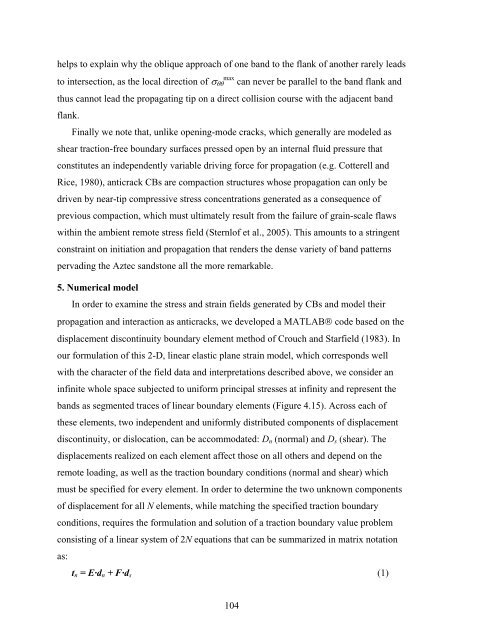structural geology, propagation mechanics and - Stanford School of ...
structural geology, propagation mechanics and - Stanford School of ...
structural geology, propagation mechanics and - Stanford School of ...
Create successful ePaper yourself
Turn your PDF publications into a flip-book with our unique Google optimized e-Paper software.
helps to explain why the oblique approach <strong>of</strong> one b<strong>and</strong> to the flank <strong>of</strong> another rarely leads<br />
to intersection, as the local direction <strong>of</strong> σθθ max can never be parallel to the b<strong>and</strong> flank <strong>and</strong><br />
thus cannot lead the propagating tip on a direct collision course with the adjacent b<strong>and</strong><br />
flank.<br />
Finally we note that, unlike opening-mode cracks, which generally are modeled as<br />
shear traction-free boundary surfaces pressed open by an internal fluid pressure that<br />
constitutes an independently variable driving force for <strong>propagation</strong> (e.g. Cotterell <strong>and</strong><br />
Rice, 1980), anticrack CBs are compaction structures whose <strong>propagation</strong> can only be<br />
driven by near-tip compressive stress concentrations generated as a consequence <strong>of</strong><br />
previous compaction, which must ultimately result from the failure <strong>of</strong> grain-scale flaws<br />
within the ambient remote stress field (Sternl<strong>of</strong> et al., 2005). This amounts to a stringent<br />
constraint on initiation <strong>and</strong> <strong>propagation</strong> that renders the dense variety <strong>of</strong> b<strong>and</strong> patterns<br />
pervading the Aztec s<strong>and</strong>stone all the more remarkable.<br />
5. Numerical model<br />
In order to examine the stress <strong>and</strong> strain fields generated by CBs <strong>and</strong> model their<br />
<strong>propagation</strong> <strong>and</strong> interaction as anticracks, we developed a MATLAB® code based on the<br />
displacement discontinuity boundary element method <strong>of</strong> Crouch <strong>and</strong> Starfield (1983). In<br />
our formulation <strong>of</strong> this 2-D, linear elastic plane strain model, which corresponds well<br />
with the character <strong>of</strong> the field data <strong>and</strong> interpretations described above, we consider an<br />
infinite whole space subjected to uniform principal stresses at infinity <strong>and</strong> represent the<br />
b<strong>and</strong>s as segmented traces <strong>of</strong> linear boundary elements (Figure 4.15). Across each <strong>of</strong><br />
these elements, two independent <strong>and</strong> uniformly distributed components <strong>of</strong> displacement<br />
discontinuity, or dislocation, can be accommodated: Dn (normal) <strong>and</strong> Ds (shear). The<br />
displacements realized on each element affect those on all others <strong>and</strong> depend on the<br />
remote loading, as well as the traction boundary conditions (normal <strong>and</strong> shear) which<br />
must be specified for every element. In order to determine the two unknown components<br />
<strong>of</strong> displacement for all N elements, while matching the specified traction boundary<br />
conditions, requires the formulation <strong>and</strong> solution <strong>of</strong> a traction boundary value problem<br />
consisting <strong>of</strong> a linear system <strong>of</strong> 2N equations that can be summarized in matrix notation<br />
as:<br />
tn = E·dn + F·ds (1)<br />
104
















